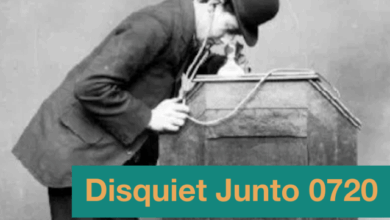Guest blog – Walshaw Turbine 13 by Nick MacKinnon – Mark Avery


Nick MacKinnon is a freelance teacher of Maths, English and Medieval History, and lives above Haworth, in the last inhabited house before Top Withens = Wuthering Heights. In 1992 he founded the successful Campaign to Save Radio 4 Long Wave while in plaster following a rock-climbing accident on Skye. His poem ‘The metric system’ won the 2013 Forward Prize. His topical verse and satire appears in the Spectator, and his puzzles and problems in the Sunday Times and American Mathematical Monthly. Email: nipmackinnon@gmail.com
Turbine 13 Grey Fosse Clough South SD 96229 34518 ///poem.converter.exacts
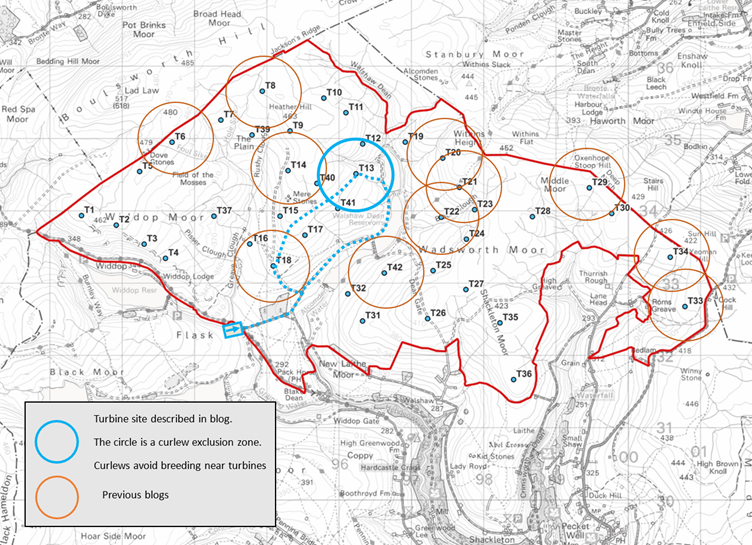
Logika, CWF Ltd, Robbie Moore M.P., Josh Fenton-Glynn M.P., and Fozia A Gulzar, the CWF Ltd auditor were sent this blog for comment on 27 October 2025.
Since first being alerted to the possibility on 30 September 2025, Logika and CWF Ltd have neither explained nor denied the prima facie A.I. hallucination in their Scoping Report that we call the work of “Marvin”. Neither Logika nor CWF Ltd have contested the statement, published here on 3 October 2025 with extensive evidence, that the CEP Scoping Report is incompetent. This blog will describe the useless and careless work of Logika on hydrology as showing “contempt for the people of the Calder valley”. It concludes with a discussion of whether CWF Ltd are at risk of trading while insolvent.
22 October 2025 Of all the many reprimands that Logika and CWF Ltd got for their incompetent Scoping Report, the most potent was from the Environment Agency.
“The scope of proposed Flood Risk and Drainage Strategy described here is not sufficient or in accordance with the Flood Risk Assessment requirements as set out in National Policy Statement EN-1, paragraph 5.8.15. The document, as described, would not provide an accurate and robust assessment of flood risk associated with the proposed development. An inadequate assessment of flood risk could result in insufficient flood risk mitigation measures being put in place and an increase in flood risk, both offsite and to the proposed development.
In particular, the FRA should […] demonstrate that a sequential, risk-based approach has been used to inform site layout and design, with development steered towards the areas with the lowest risk of flooding, taking all sources of flood risk and climate change into account. Only where there are no reasonably available sites in low and medium risk areas should high flood risk areas be considered for development.”
Nobody knows better than readers of Walshaw Turbines that a risk-based approach to flooding was not used to inform the design of the layout used in the Scoping Report. Christian Egal has never protested our account of his layout meeting of 21 February 2025, “The Day of the Eagle”.
Today we walk to T13, one of three sites that hang on the edge west of the reservoirs. These have gone unvisited in the blogs in favour of more glamorous places, though John Page has done a masochistic traverse T12-T13-T41 to extinguish the idea that a track might link these along the contour. He found Grey Fosse Clough “very difficult indeed” and it took him an hour to get from T12 to T13, just 2.5 rotor diameters and he is still a VS rock-climber.
T12, T13 and T41 are flooders. The tracks down to them from the plateau will focus and accelerate storm water. In normal conditions the same tracks will dry the peat for hundreds of metres either side, like French drains. The turbines themselves are on absurdly steep ground, and this is the key thing to understand about the central section of CEP.
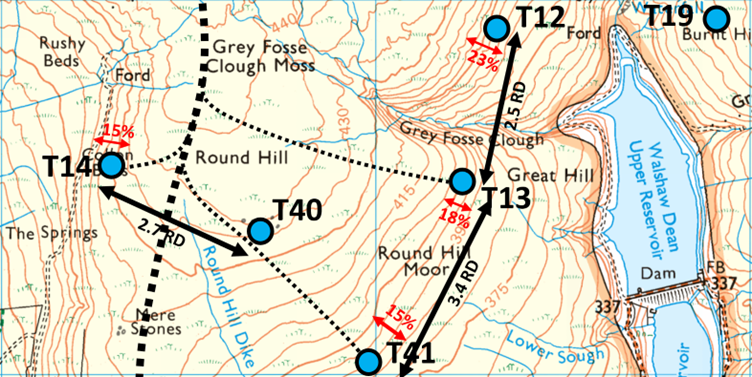
Following the route of the turbine blades (in reverse), the dog and I go straight up from Sutcliffe Plantation. As though to prove the West hypothesis on the BESS, some logging is going on inside. At the wall separating Greave Pasture from the moorland, we walk along the grouse pegs looking for a quadbike gap.
The Heather Hill plateau seems vast compared with the size of a wind turbine foundation, but as we passed through the wall I said to the dog, “Wind turbines don’t need much earth, but they need a lot of air.” It is a fact you can lose sight of when looking at a single row of turbines by the motorway. The Vestas 162/7.2 MW turbine continuously sucks kinetic energy out of a block of air that is 3 RD (486 m) wide and at least 5 RD (810 metres) long, leaving a wake of slow, low pressure turbulent air behind it. This wake partially refills (mainly from higher pressure air above) before the next turbine downwind. Ideally UK turbines would be much further apart downwind: 6-10 RD is usual internationally.
T40 and T41 are correctly spaced 3 RD apart across the prevailing wind, but T14 is too close to T40 at 2.7 RD. Downwind, T41 is far too close to T13 which is far too close to T12. Heather Hill is only wide enough for a single line of turbines along the top, served by a spine track. T12 will be damaged by T13 turbulence and suffer increased operating expenditure. The pension fund that buys CEP should ask for it to be written off on day one. It’s broken-down pensioners they finance, not broken-down turbines.
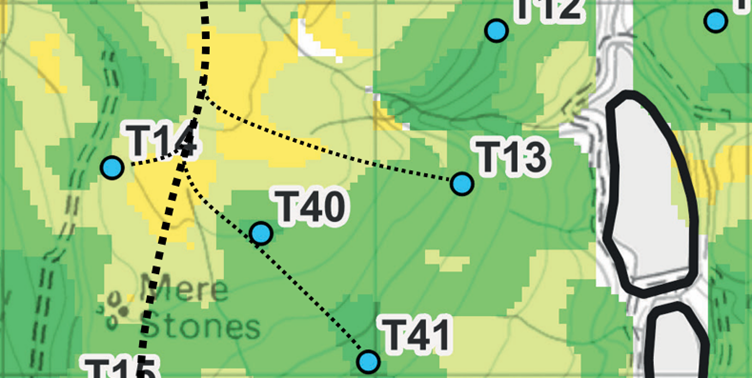
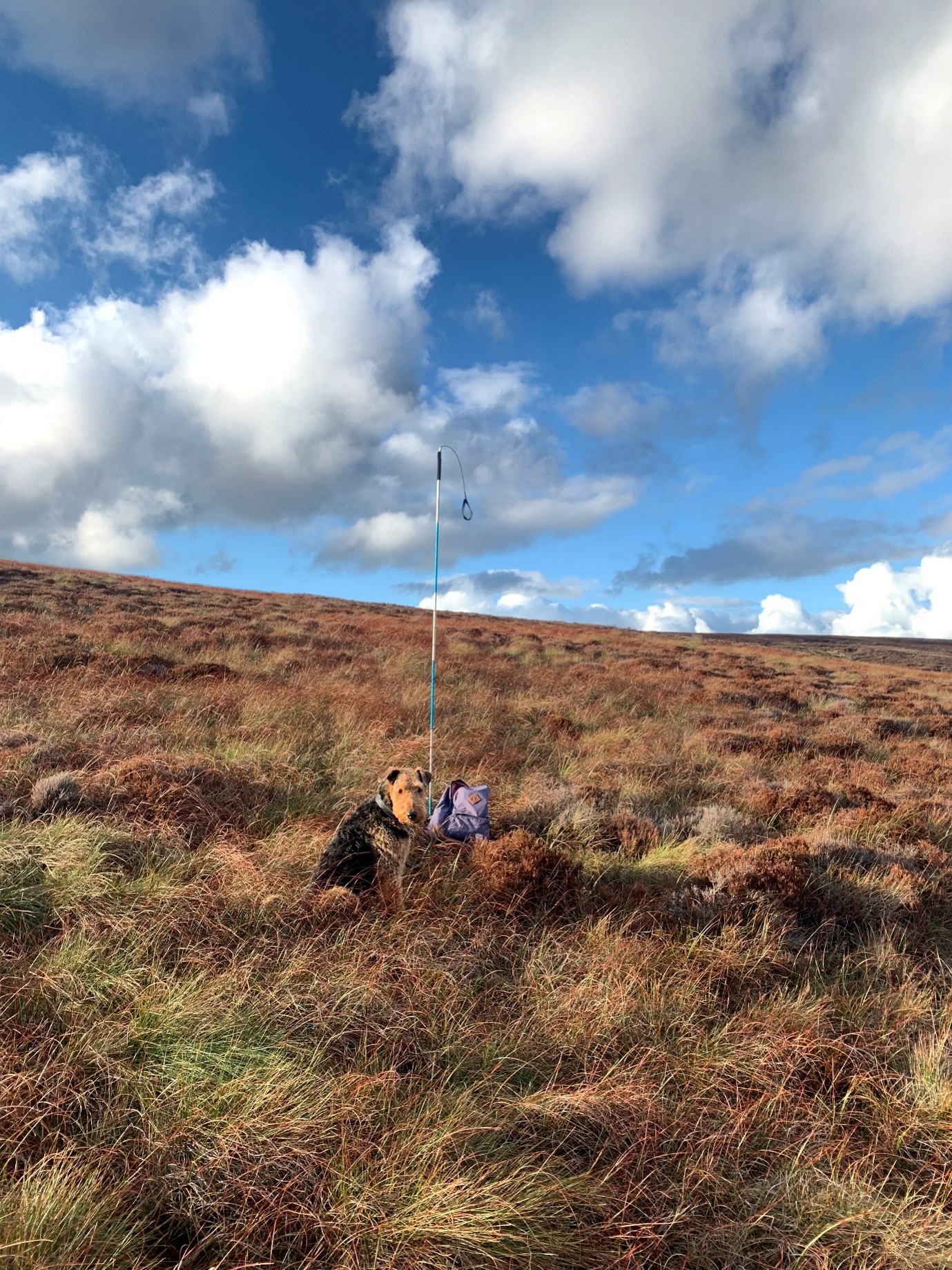
It is difficult to find the site of T13 by eye. I keep wanting flatter ground, but the six-figure reference is implacable and eventually we puff back up the hill to the steepest place around. There is 90 cm of peat. The survey shows it gets deeper still above, so excavating the slope would have to be done carefully with a view to the risk of a peat slide from a steep unsupported mass above. This is a crazy site, but T12 on the other side of Grey Fosse Clough is crazier still. At both, vast amounts of peat, earth and rock would have to be removed to get a level platform for the concrete foundation, the permanent hardstanding for the crane and the temporary lay downs for the components.
The map below shows the excavation for T13 to scale. The depth is 18 metres at the west end of the hardstanding and 28 metres deep (a 10-storey house) as the track enters the platform. The destruction of the SAC for T12 north of Grey Fosse Clough will be even more extreme, as would be the effect on storm flow, but we shall keep that one for another day. Look at those converging contours! T13 could be rotated parallel to the contours, but that involves a traversing track across deep peat, which I must not encourage.
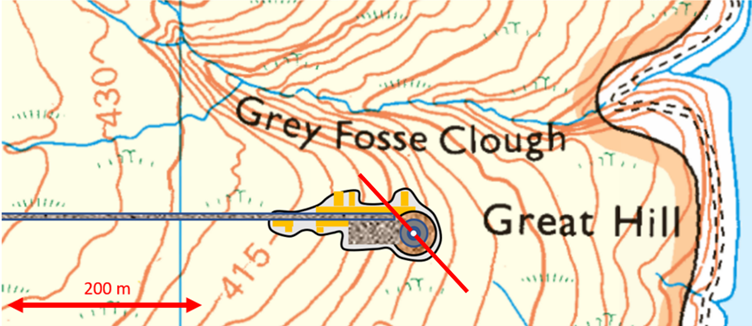
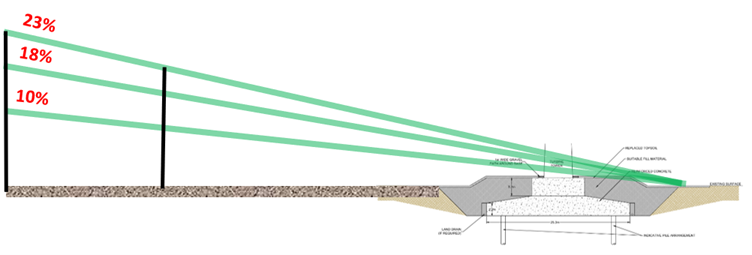
The amount of earth removed to create the flat platform for the foundation and hardstanding is proportional to the slope percentage. If the access track and hardstanding are parallel to the contours, the platform is narrower and longer. As the width of the rectangular platform is about 70% of the length, this narrower platform would require 70% of the soil removal. If the platform is modelled as a rectangle x by y with x > y and the slope gradient is g, the removed soil is gxy2 parallel to the contours or gx2y perpendicular to the contours.
A wind turbine is not built on a slope of more than 10% gradient unless there are very pressing reasons, and you don’t choose 10% if you can resite to 4% with 60% less spoil. Building on the steeper ground also inevitably increases the speed of storm-water run-off.
The “very pressing reason” for all the 10%-24% turbine sites on CEP is that the consultants are trying to keep the “300 MW” train going so the investors maintain the gravy supply. At CWF Ltd, which the accounts state has zero employees, everyone is a self-employed consultant, including the Executive Chairman Christopher ‘440 Kelvin Volts’ Wilson. As the size of CEP drifts down towards 100 MW, the incentives for the consultants and the investors become misaligned.
The dog and I follow the path of the storm water towards the reservoir. We are already deep in the tough bracken when I remember the wall. I hope to sneak under at a stream, but it is expertly grilled. Sideways movement is murder on this ground, but I spot some almost invisible half-boot-wide drystone steps, and after dead-lifting 28 kg of frightened dog onto the top, I can edge past and lift him down the other side. It is a superb wall, dating to Enoch Tempest’s building of the reservoirs in 1906. I bless the unknown craftsman who inserted the fairy steps two lifetimes ago.
Christian Egal’s layout for CEP is so weird that we must look at a real wind farm to get our eye in.
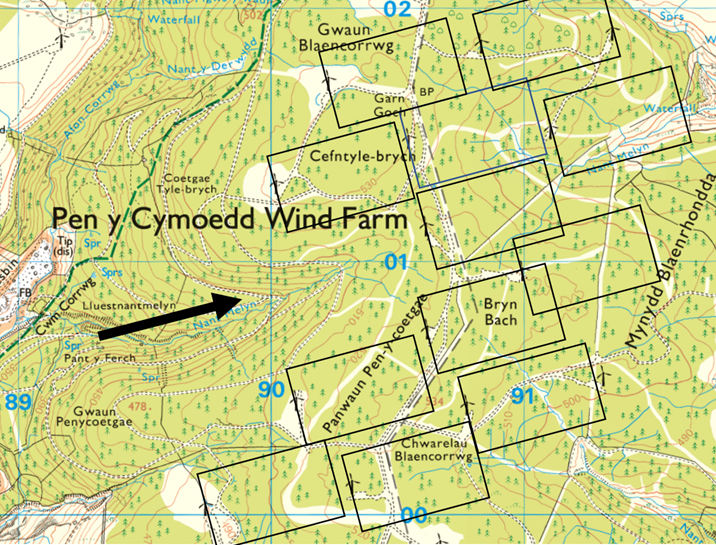
Pen y Cymoedd (228 MW) was developed by Vattenfall on land owned by the former Welsh Forestry Commission, with 76 Siemens 108/113 3 MW turbines. The map above shows the 3 RD by 5 RD spacing rectangles in the direction of the prevailing wind from bearing 255°; the footprints have hardly any overlap; wind turbines don’t need much earth, but they need a lot of air. The terrain here is like Walshaw Moor, with flat ridges above tight valley heads, but 100 metres higher. The Welsh ground is much steeper than the Pennines in places, and the contour interval on the Welsh map is 10 metres rather than the 5 metres of the CEP maps in this blog. The site choice was excellent. The track network uses some of the existing forestry roads that were already suitable for HGVs; the peat had already been lost to the conifers; the aggregates were all sourced on site; the National Grid 400 kV substation is only 6 km north at Rhigos; and the site was neither SPA, nor SAC, nor pledged to our Kunming-Montreal 30 by 30 obligations on biodiversity, nor alive with curlews (almost extinct in Wales) nor the inspiration for three of the most famous women in the history of the world.
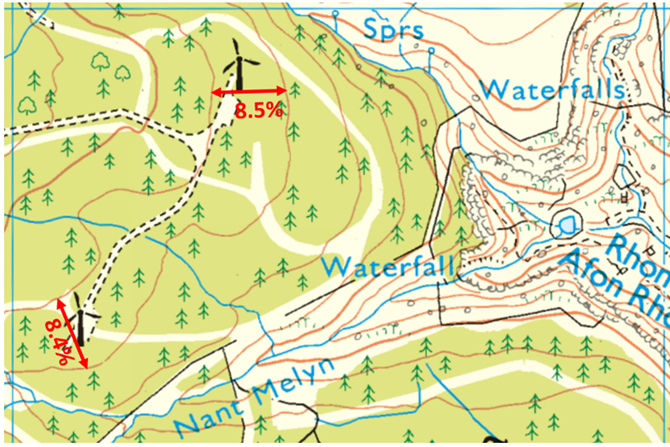
The maximum gradient of any turbine site on Pen y Cymoedd is the 8.5% shown in the map above, and these two turbines are outliers on the steepest section. The crucial difference in terrain from Walshaw Moor is that the flatter ground was available in Wales. This made the dig much less destructive and simpler, and reduced flood risk. The typical slope under the Pen y Cymoedd turbines is 0-4%.
Now compare this normal, correctly spaced wind farm, on a well-chosen site, developed by the reputable Vattenfall, with the bizarre, grossly overcrowded, central section of CEP that is likely to flood Hebden Bridge and the Calder valley by increasing peak flow.
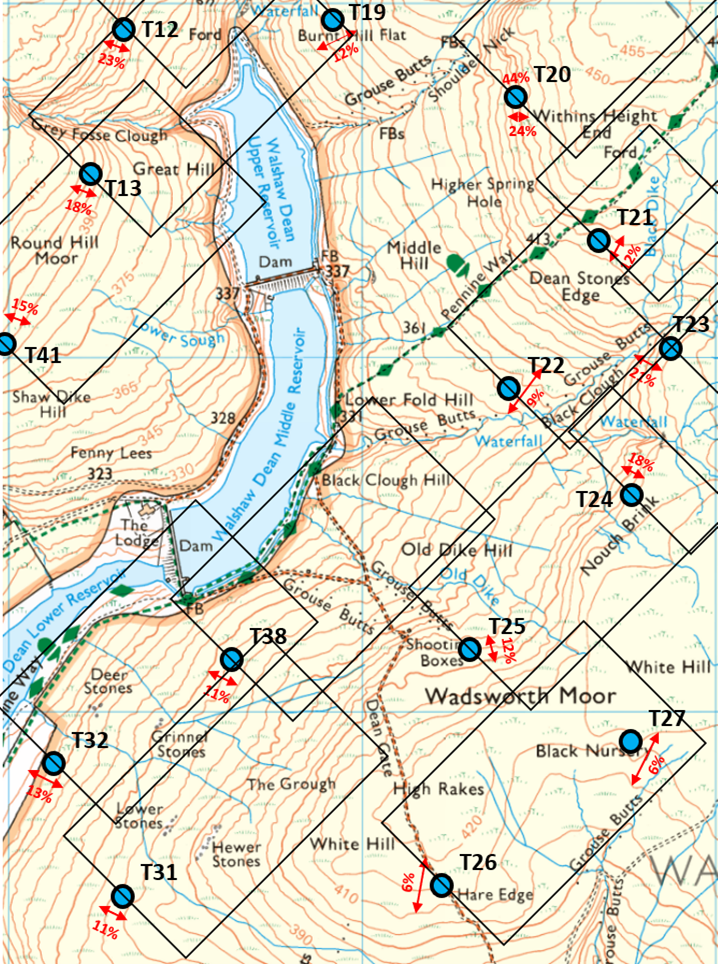
None of these fifteen CEP turbine sites has been chosen using a “risk-based approach … to inform site layout and design” as the EA require. They are not the result of any kind of proper design process. Every turbine in this central section, including the two at 6%, is on unnecessarily steep ground so that their spur tracks, hard standings and concrete foundations greatly increase the flood risk. Most of them will have to be deleted because they require deep gouges into the Special Area of Conservation. They are also much too close together. This nonsense has been paraded at three public exhibitions, a Non-statutory Consultation and forms the incompetent basis of an incompetent Scoping Report.
This is the Walshaw terrain problem. Where the slope is less than 10% the peat is usually 2 to 6 metres deep. To make his CEP layout, Christian Egal pushed the turbines off the deepest peat. By his own design he has admitted that it is unacceptable to chew up the deepest peat for turbine foundations and so he must risk flooding Hebden Bridge instead. The bizarre CEP layout is the consequence.
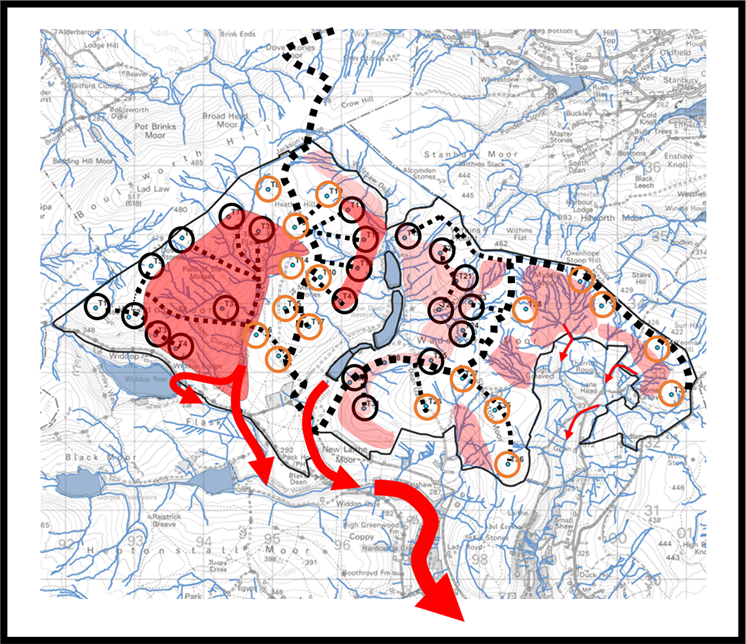
I had to go back to the old Natural Power hydrology base map to make my map above. If anyone at CWF Ltd has a shred of respect left for Logika after the Scoping Report debacle, they need only compare the hydrology map made by Natural Power, who were either sacked or got out while the going was good, and the utterly useless Logika hydrology map (below) contour-less, grid-less, sluice-less, tunnel-less, flat as the Al Hammad Plateau, but wetter.
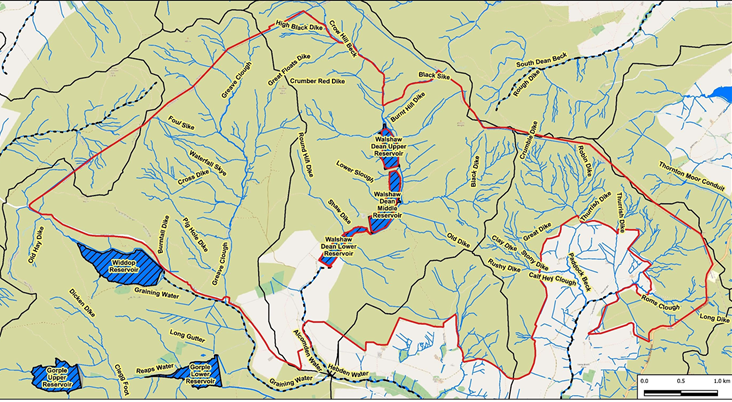
Random drains and streams have been named or misnamed as though by a child with a Dymo label gun. The major feature of our blog today, Grey Fosse Clough, dividing T12 from T13, goes un-named. Logika prefer tiny Lower Sough, but they think it is “Slough” and they have stuck that wrong name on Gull Dike.
Thurrish Dike (in the hook) appears twice, once going uphill, once downhill, but Thurrish Dike is a drain on the boundary to Thurrish, which is well south of the turbine area. The main flood feature leaving the turbine site here is Mares Greave Clough which gathers the whole drainage tree and doesn’t get named. You need only look at the 6-inch map to get this stuff right, but first you must care about hydrology, which Logika don’t, on this showing.
A section of the Scoping Report written by Marvin, the Logika robot says:
“4.3.11 A large area at risk of surface water flooding, on the western side of the Turbine Area, is the Waterfall Syke and Cross Dike.“
What Marvin means is “the whole slope drained by Cross Dike and Waterfall Syke is at risk of surface flooding”, yet this is where the access track must go to reach T1-T6. The wobbly Logika Dymo-label calls the critical feature “Waterfall Skye”.
The green shading that would have obscured the contours, had Logika thought slope was important on a hydrology map, has no hydrological significance, nor is its meaning given in the key. It is an impression of the South Pennine SAC and SPA for red-listed birds, but it doesn’t agree with Defra’s MAGIC map south of the Walshaw Dean lower reservoir where the vast curlew flock gathers to feed, photographed by Kate Haslegrave. Again, Natural Power got this point right. The client has paid Logika for a misleading map about their responsibilities to the curlews on Walshaw Moor, when they already had a much better correct map.
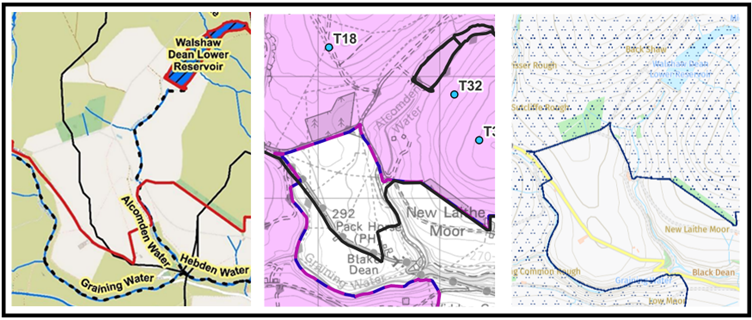
This careless, useless Logika hydrology map is the measure of how bothered CWF Ltd and Logika are about the flooding they would cause. It shows their contempt for the people of the Calder valley and the statutory consultees who will try to protect them. It also shows Logika’s contempt for a client who had already paid for a much better map from Natural Power. Did Natural Power jump, or were they pushed? I only have James Lightbody’s statement on that, when I rang them up in May 2025 to ask if they were responsible for the hash Christian Egal had made of the maps on Launch Day which had the Natural Power logo on them. “I did some work on a wind farm somewhere near Halifax ages ago, but I don’t have anything to do with it now.”
If M. Egal is now made to keep off the most dangerous ground for flooding, made to avoid the flood-driving 10% -24% sites which are destructive to the SAC (and expensive to dig anyway) and made to space his turbines like all the reputable developers do, and indeed the way EDF did when M. Egal was CEO of its UK renewables, then Walshaw Moor would struggle to host even 100 MW.
The consultants know all this but will carry on spending until the naïve Saudis finally cut the Bisto, which they should have done in October 2024. We knew CWF Ltd were broken. Then they hired Logika.
The consultants’ chief concern should legitimately be for their own reputations, tarnishing by the day now the proposal is unravelling in public. The CWF Ltd senior consultants (Sue Bernie, Alison Sidgwick, Donald Mackay) know the Logika Scoping Report was a fiasco. They know the Natural Power maps were good and the Logika maps are terrible. Not since Donald Mackay played Yum-Yum in the Gaelic version of Am Mikado has he been part of a performance as hilarious as the Logika Scoping Report for Calderdale Energy Park.
Who can tell Christopher Wilson that the game is up? My money is on Donald Mackay.
Even straw-in-the-wind Calder Valley M.P. Josh Fenton-Glynn, caught between his misapprehension of what Government policy means for CEP (DESNZ/Defra Unlocking benefits 1.1) and the fury of his own constituents who would be flooded by Christian Egal’s weird layout, has finally started to get the drift. He must look enviously at Conservative M.P. Robbie Moore, who has been campaigning on Walshaw Moor peat and curlews since he spoke to the Stronger Together meeting at Lydia’s meeting in Haworth with me and Mark Avery. We all thought it an excellent performance; Pam Johnson of Keighley Labour was also terrific that night (“This looks to me like a venture capital scam, not a serious wind farm.”) First questions from the audience were, “Where is Josh Fenton-Glynn? Was he invited? Will he come?” We don’t know. He was. He didn’t. It is likely that Robbie Moore will be the leader of his rather smaller party after the next general election. You can get 100-1 on him at William Hill. Remarkably, Robbie Moore is perfectly aligned with DESNZ/Defra joint policy on wind-on-SAC-peat, yet it is JF-G’s constituency that’s going to be flooded. Still, if JF-G puts the boot in now, he might win back some floating voters from the Greens and Reform. Better late than never. Speak for Calderdale, Josh!
There must be a frank discussion (chaired by the PR firm Cavendish Consulting) between the lead consultants, an Executive Chairman who thought the National Grid ran at 440 Kelvin Volts and that Padiham was a suburb of Rochdale, the lawyers, the auditor and the investors represented by Dr Osman, who stepped back as the only human person of significant control on 19 May 2025 and has thus lost some of the grip he once had on the spending. There is a danger that the Saudis have been shelling out under false pretences. It may be that Dr Osman is a prisoner at the Hotel Calderdale of his consultant captors who are “programmed to receive; he can check out any time he likes, but he can never leave.”
If there is no prospect of a viable wind farm that can pay for its connection, CWF Ltd are at risk of trading while insolvent. Like any start up, they are only allowed to burn through the investors’ cash while they believe in good faith that there is a realistic chance of reasonable success. CWF Ltd will have to present the investors with their own analysis of the flooding problem and the peat slide access problem. What they say will be more optimistic than my versions, but mine are in the public domain and on file at Logika, CWF Ltd and the Planning Inspectorate and will give the Saudis’ lawyers a guide. Christopher Wilson must also give an account of how much more of the wind farm they might lose to “within the Brontë Country” (Christian Egal’s quaint phrase). Because Logika, incompetently, have not yet asked anyone with a sense of it how serious this problem is, I shall advise them: I reckon it is between 36 MW and the whole thing, but the 36 MW is key, because it represents the turbines on the Brontë skyline that would survive the aerodynamic and flooding culls, and they are on the access track for the stone deliveries. “Within the Brontë Country” refreshes the parts other arguments cannot reach. Calderdale Council pointed this out in December 2023 and repeat their opinion in the 2025 Scoping Report.
“Innovation is likely to be required given the unprecedented nature of the proposal in an important cultural landscape such as this. The applicant is, therefore, advised to approach the Brontë Society.”
Can the Saudis get their money back? There is no payback for the Saudis in suing uninsured consultants, though Christian Egal should have Directors’ & Officers’ liability insurance against some consequences of incompetence written in to his contract as Project Director or have his own portable D&O insurance. The other entities with insured targets on their backs are Richard Bannister and the Walshaw Moor Estate, the lawyers, the auditor, Logika and Christopher Wilson.
Richard Bannister and the Estate are utterly safe under caveat emptor. He was under no obligation to express any misgivings he may have had about the aggregates or the habitat regulations which he and his gamekeepers know to the millimetre. Mr Bannister might himself want to press claims against the other parties for being so incompetent that the hope value of his grouse moor as wind farm is much reduced, but he’s had about £4 million already so he won’t. I’m going to say this. There were a hell of a lot of curlews, lapwings and golden plovers on Richard Bannister’s grouse moor in Spring 2025 and Natural England should find out what he’s doing right.
The lawyers and the auditor are presently safe, but their insurers might become vulnerable if they persist in acting for CWF Ltd without a clear explanation from the company about its prospects following the Scoping Report. I advise them to ask for reassurances.
Logika might be protected from the financial consequences of their own incompetence by a disclaimer like the one below, taken from the Glenmarkie Scoping Report, which we have used as a control on the CEP one. The Glenmarkie report was prepared by SLR, who also produced the superb visibility maps in the CEP Scoping Report. CWF Ltd should have got SLR to do the lot, but it’s too late now.
“This document has been prepared by SLR Consulting Limited (SLR) with reasonable skill, care and diligence, and taking account of the timescales and resources devoted to it by agreement with Vattenfall Wind Power Ltd (the Client) as part or all of the services it has been appointed by the Client to carry out. It is subject to the terms and conditions of that appointment.” (Glenmarkie WF Scooping Report page i)
There is no such disclaimer in Logika’s Scoping Report for CEP, but surely “reasonable skill, care and diligence” appears somewhere in their contract. The trouble for Logika is that there are so many unarguable errors in their work and they are so very much in the public domain, indeed spread all over the Planning Inspectorate website, indeed directly referenced by the Planning Inspectors themselves, that their liability insurance company’s lawyers might settle any reasonable Saudi demand by return of post. Start at £5 million to cover your minibar bill at the Hotel Calderdale, Dr O!
The reputational damage will dog Logika for ever. In future, if Logika produce work for a wind farm, the campaigners against it will dig up the history of the 2025 CEP Scoping Report, take heart from what they find here, and will ask, “Why have our developers chosen Logika?”
Did Logika show “reasonable skill, care and diligence” with that abject hydrology map? No. It is inept, careless and negligent, and if their lawyers want me to justify those three adjectives in granular detail, they can reach me at nipmackinnon@gmail.com.
Christian Egal’s D&O insurers have a lot of mistakes to defend if they don’t settle. The Saudis’ lawyers will find plenty in these blogs, and in an appendix (comprehensive up to 10 June 2025) to a legal letter WTRG sent to M. Egal setting out reasons why the non-statutory consultation was unlawful. The CWF Ltd lawyers “strongly reject” the unlawfulness, but without adducing any evidence. We sent our letter as a marker for future action on the non-compliance with the Gunning Principles, but the Saudis’ lawyers would find it useful too. Post 10 June 2025, who carries the can for not proof-reading the Scoping Report? Christian Egal, Christopher Wilson or Logika? Note that the Glenmarkie report is Revision 03. CWF Ltd recklessly sent Revision 00 of theirs to the Secretary of State.
Christopher Wilson’s D&O insurers would be in trouble facing Saudi claims of his trading while insolvent because he said at the Hilltop Parishes meeting in December 2023 that CWF was not economic below about 200 MW. He rapidly needs to obtain his consultants’ realistic view of what is left on the scorched earth of an incompetent Scoping Report, subtract a percentage for their natural optimism, and present a new range of likely outcomes to his investors. If Mr Wilson’s revised range is higher at either end than 90-150 MW, the Saudis’ lawyers can always drop me an email for a second opinion.
This is not over, but if CWF Ltd are to continue trading, they must have a verifiable story to tell their investors, their auditor, their lawyers, and perhaps even the electricity bill-payers and tax payers who must service the mortgage, and this story needs to be more detailed than Christian Egal’s Gallic insouciance:
“It’s very windy up there.”
++++++++++++++++++++++++++++++++++++++++++++++++
This is the 47th in a series of guest blogs originally based on the 65 wind turbines which Richard Bannister planned to have erected on Walshaw Moor. Turbines 5, 6, 6CEP, 8, 8CEP, 9, 11, 13, 14CEP, 14, 16, 17, 18CEP, 20CEP, 21, 21CEP, 22CEP, 25, 25CEP, 27, 29CEP, 31, 32, 33, 33CEP, 34, 34CEP, 35, 36, 37, 38, 40, 42, 42CEP, 43, 44, 47, 53, 54, 56, 57, 58, 60, 62, 64 and 65 have already been described.
The developers have canned their original 65 wind turbines, quite possibly in response to the public humiliation of having their so-called ‘plan’ publicly shown to be damaging, irrational and probably unlawful. They have come back with a plan for 42 wind turbines and the amazing Nick MacKinnon and friends have regrouped and set off on a new tack too. The series continues.
To see all the blogs – click here.
[registration_form]

